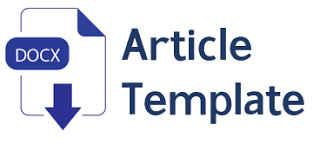STUDENTS' PERCEPTIONS OF THE IMPLEMENTATION OF TEACHING STRATEGIES IN THE TRANSLATION SUBJECT
Abstract
Transferring knowledge to pupils is one of a teacher's most important responsibilities when it comes to teaching. Due to its ability to assist students in overcoming the challenge of translation competence, the blank technique is perceived as one of the research's lessons. Ideas are transferred from the source language to the target language during translation, and the meaning remains the same. For students to learn through the lecture method and to comprehend the content, translation is therefore crucial to the process of learning. A qualitative method was used for this study. Then the research instruments used questionnaires and interviews. The total number of respondents is 13 English Language Education students from STAIN Bengkalis. According to the findings, the majority of students appreciate and benefit from lecturing on the teaching technique. It demonstrated that children study translation because it is enjoyable for them and makes it easier to understand words and sentences. Students who learn translation can help them organize the meaning methodically and increase their knowledge, particularly vocabulary, understanding the text's point of view, and comprehending the text's meaning. It signifies that the teaching technique used in translation class was acceptable and increased students' translation skills. While the results from the interview in this study also revealed that students enjoyed learning translation subjects in order to develop their grasp of the meaning of a text, competence in translating a text, and competence in comprehending English language.
Full Text:
PDFReferences
Augustyn, P. (2013). Translation and Bilingual Practice for German Vocabulary Teaching and Learning. Die Unterrichtspraxis/Teaching German, 46(1), 27–43. https://doi.org/10.1111/tger.10127
Asgarian, Amir. (2012). The Iranian EFL Teachers' Perception on Translation Strategy Use. Eastern Mediterranean University, Department of ELT, Education Faculty,Famagusta, EMU-98000, North Cyprus
Apelgren, K., and Giertz, B. (2010). Pedagogical Competence–A Key to Pedagogical Development and Quality in Higher Education. Pedagogical Competence.
Bhooth, A, Azman, H, & Ismail, K. (2014) The Role of the L1 as a Scaffolding Tool in the EFL Reading Classroom. Procedia-Social and Behavioral Sciences.
Creswell, John W. (2008). Educational Research Planning, Conducting, and Evaluating Quantitative and Qualitative research. Pearson Prentice Hall
Dagiliene, I. (2012). Translation as a Learning Method in English Language Teaching.
Studies about Language.
Goebel, R. J., Curran, J. V., Fricker, C., & Faull, K. (2008). The Role of Translation in German Studies, Responses. The German Quarterly, 81(4), 489–492. https://doi.org/10.1111/j.1756-1183.2008.00033.x
Hornby, A. S. (2004). Oxford Advanced Learner" s Dictionary. 6 th Edition. Oxford: Oxford University Press.
Kartinisari, K,R et al. (2018). Teacher's Use of Translation as Instructional Strategy in Teaching English. Universitas Pendidikan Ganesaha
Mart, C, T. (2013). The Facilitating Role of L1 in ESL Classes. International Journal of Academic Research in Business and Social Science.
Mohamed, J. (2014). Use of translation in the Classroom by EFL Teachers in Libya (A Descriptive Study). Arab World English Journal.
Popovic, R. (2001). The Place of Translation in Language Teaching. Paper in English Teaching Forum, 37(2).
Raju, E.R.B. (2016). Translataion as a Catalyst in an EFL Classroom. Journal of the English Literator Society, an International Open Access Refereed Research Journal, 1(3), 184-191. Retrieved April 10, 2017, from https://www.els.ngo/jels/2455-393X-34.pdf.
Ridha Abdul, Salih, Nada. (2014). Associations between EFL Learners' Beliefs about and Their Strategy use of Translation in English Learning: The Case of Iraqi Learners. University of Basrah
Ross, N.J. (2000). Interference and Intervention: Using Translation in the EFL Classroom. Modern English Teacher.
Siregar, Masitowarni. (2019). Pedagogical Translation use by Scientific Approach in Teachig English. Universitas Negeri Medan: Indonesia
Sudarno, A., P. (2011). Penerjemahan Buku Teori dan Aplikasi. Surakarta : UNS Press.
Tisgam, K. H. (2009). Is it possible to teach translation in the classroom? J. Of College Of Education for Women, 20(2)
Tsai, Yvonne, Tsai, Amanda. (2017). Flipped Translation Training: The Students Perception. Studies in English Language and Literature
Reece, Ian., Walker, Stephen. (2003). Teaching, Training and Learning. Great Britain. Oxford
Ross, N. J. (2000). Interference and Intervention: Using Translation in the EFL Classroom. Modern English Teacher.
Wiratno, T., (2003). Text Deconstruction in English Language Teaching. The 2nd International Seminar on English Language Studies, Universitas Sanata Dharma: Yogyakarta
Zhao, Y. (2015). Using Translation in ESL Classrooms: An Asian Perspective. International Journal of Innovative Interdisciplinary Research.
DOI: https://doi.org/10.35314/inovish.v9i1.4253
Refbacks
- There are currently no refbacks.




